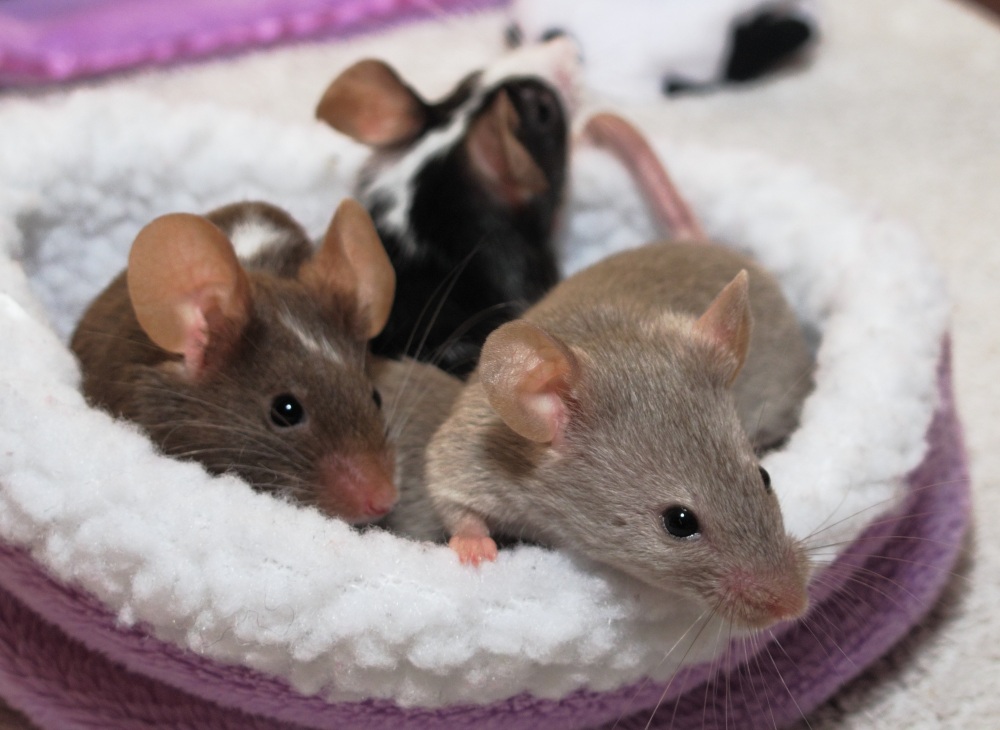What do I need to know about reproduction in mice?

Mice mature and can breed at a young age (even as young as four weeks of age), breed prolifically, and have large litter sizes. They will come into season every 4-5 days unless pregnant; their pregnancy duration is 19-21 days; their litter size is 7-11 pups; and they can be ready to mate again 24 hours after giving birth. The pups are weaned at 18-21 days of age, by which time their mother may be ready to deliver another litter.
Ideally, mice should be kept in groups formed before they are weaned, ideally siblings, and the group should not be changed. It is preferable to only keep mice in compatible single-sex groups. Single-sex groups of females usually get on well together. However, keeping intact (non-desexed) adult males together can be a problem as they may be aggressive with one another, so male mice being kept together should be desexed. Although it is not generally recommended to keep males and females together, if you must, the male mice should be desexed.
Unless you want to breed your mice, you only have two choices: preferably only keep mice of the same sex together or, if you must keep males and females together, have the males desexed as soon as possible and keep them separate to females from before six weeks of age until after they are desexed so no unwanted pregnancies result (speak to your veterinarian about the timing).
Make sure that young males of six weeks or older are not left with their female littermates and/or mother unless they are desexed, or unwanted pregnancies will likely result. Females can mature and breed from four weeks of age, so should be separated from adult males (e.g., their father) before four weeks of age to avoid unwanted pregnancies.
So, you will need to know how to tell the sexes apart. Even an experienced veterinarian, breeder, pet store owner, or animal shelter can make sexing mistakes, so take a look yourself to double check.
Sex identification
There are a few ways to determine if a mouse is male or female, but no method is completely reliable all of the time.
- Males are typically twice the size of females.
- Adult males can be distinguished from females by the presence of a scrotal sac which contains the testes. Note though, that the testes may not be obvious until 3-4 weeks of age, and that mice can retract their testes into the abdomen, making it difficult sometimes to be sure.
- The distance between the anus and the genital opening (the anogenital distance) is longer in the male compared to the female (about twice as long). You may need to look at a few different mice to get an idea of the approximate appearance of the distances of both sexes.
Desexing
Desexing prevents the unwanted litters described above, and also reduces male scent marking in mice and may help male mice to live together peacefully.
Desexing of male mice is recommended and becoming a common veterinary procedure. Female mice are not usually desexed because of their small body size. Desexing of female mice is not generally recommended unless the mouse has a specific problem with her reproductive organs that requires desexing.
Speak to your veterinarian about the optimal timing for castration of male mice (and do it as early as possible!). Also ask if male and female mice should be kept separated after desexing and for how long so that there is no risk of unwanted pregnancy.
Breeding
If you do want to breed your mice, they should not be bred before eight weeks of age, and you should ensure that you can find good homes for all of the babies before breeding.
Bibliography
Banks RE, Sharp JM, Doss SD, Vanderford DA (2010) Mice. In: Exotic Small Mammal Care and Husbandry. Wiley, pp 73–80
Frohlich J (2020) Rats and mice. In: Quesenberry KE, Orcutt CJ, Mans C, Carpenter JW (eds) Ferrets, rabbits and rodents, 4th ed. W.B. Saunders, pp 345–367
Pilny AA (2015) Small Exotic Companion Mammal Wellness Management and Environmental Enrichment. Veterinary Clinics of North America – Exotic Animal Practice 18:245–254
Was this article helpful?
This work is licensed under a Creative Commons Attribution-NonCommercial-NoDerivatives 4.0 International License.


